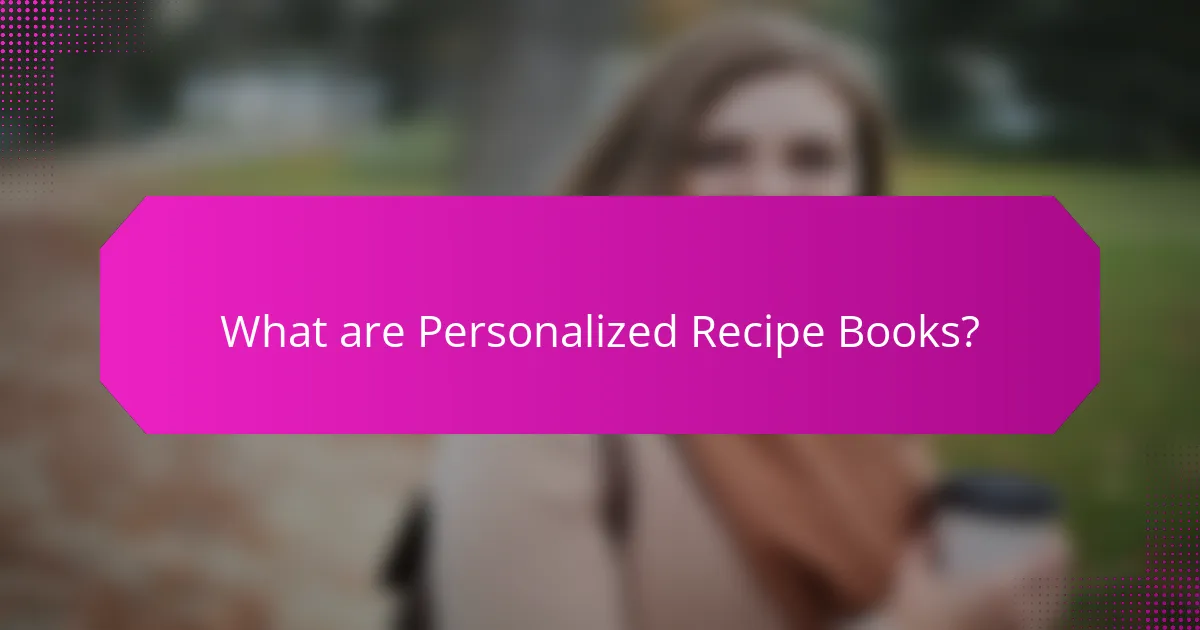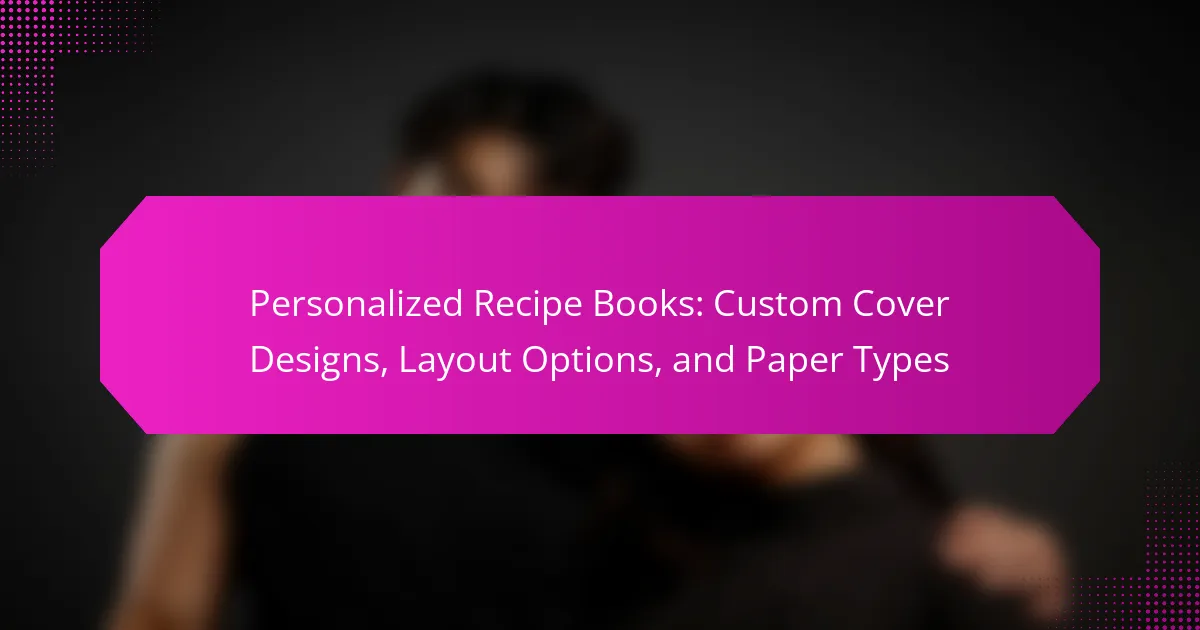Personalized recipe books are custom collections designed to reflect individual cooking preferences, featuring options for personal notes, photos, and unique cover designs. These books can vary in layout from traditional to modern and allow users to select paper types that match their aesthetic and practical needs. The customization of recipe books enhances the cooking experience and adds sentimental value, especially when they include family recipes passed down through generations. Custom cover designs not only increase the visual appeal of the books but also foster emotional connections, making them ideal gifts or cherished family heirlooms. This article explores the various aspects of personalized recipe books, including cover designs, layout options, and paper types.

What are Personalized Recipe Books?
Personalized recipe books are custom-made collections of recipes tailored to individual preferences. They allow users to include personal notes and photos. These books can feature unique cover designs that reflect the owner’s style. Layout options can vary from traditional to modern formats. Users can choose paper types that suit their aesthetic and practical needs. This customization enhances the cooking experience. Personalized recipe books often serve as cherished gifts or family heirlooms. They can include family recipes passed down through generations, adding sentimental value.
How do Personalized Recipe Books differ from standard cookbooks?
Personalized recipe books differ from standard cookbooks primarily in their customization options. Personalized recipe books allow individuals to tailor content to their specific tastes and dietary preferences. They often include custom cover designs, unique layouts, and personalized notes. Standard cookbooks typically offer a fixed collection of recipes without such customization. The personalization can enhance the emotional connection to the book. Additionally, personalized books may feature family recipes or cherished memories, making them unique. Standard cookbooks focus on a broader audience, lacking this individual touch. This distinction makes personalized recipe books more meaningful for users.
What unique features do Personalized Recipe Books offer?
Personalized Recipe Books offer unique features such as custom cover designs, tailored layout options, and various paper types. Custom cover designs allow individuals to express their personality and style. Tailored layout options enable users to organize recipes according to their preferences. Different paper types enhance the tactile experience and durability of the book. These features cater to personal tastes and practical needs. Additionally, the personalization aspect makes each recipe book unique to the owner. This customization enhances the emotional connection to the recipes contained within.
Why are Personalized Recipe Books becoming popular?
Personalized recipe books are becoming popular due to their ability to cater to individual tastes and dietary needs. These books allow users to compile favorite recipes, creating a unique culinary collection. Customization options enhance the personal touch, making each book a reflection of the owner’s personality. The rise of social media has also fueled interest in sharing personalized recipes. Additionally, consumers increasingly seek meaningful gifts, and personalized recipe books serve this purpose well. According to a survey by The NPD Group, 45% of consumers prefer customized products over standard options. This trend highlights the growing desire for personalized experiences in various aspects of life, including cooking.
What elements contribute to the personalization of Recipe Books?
Elements that contribute to the personalization of recipe books include custom cover designs, layout options, and paper types. Custom cover designs allow users to select colors, images, and text that reflect their style. Layout options enable the arrangement of recipes, photos, and notes according to personal preferences. Paper types can vary in texture and weight, affecting the book’s feel and durability. These elements enhance user engagement and create a unique cooking experience. Personalization makes the recipe book a cherished keepsake rather than just a collection of recipes.
How do custom cover designs enhance the appeal of Recipe Books?
Custom cover designs enhance the appeal of recipe books by creating a unique visual identity. A well-designed cover captures attention and reflects the book’s content. It can convey themes such as cuisine type or cooking style. Unique artwork or typography can make the book stand out on shelves or online platforms. Engaging visuals can evoke emotions and spark curiosity. Studies show that consumers often judge a book by its cover, influencing their purchasing decisions. Custom covers can also personalize the book for gifting, making it more meaningful. Overall, they play a crucial role in attracting potential readers.
What layout options are available for Personalized Recipe Books?
Personalized Recipe Books offer several layout options. Common layouts include single-page designs, double-page spreads, and grid layouts. Single-page designs feature one recipe per page for easy reading. Double-page spreads allow for larger images and more detailed instructions. Grid layouts organize recipes in a compact format, ideal for quick reference. Additionally, some options include customizable sections for notes or family recipes. These layouts enhance usability and personalization.
How do different paper types affect the overall quality of Recipe Books?
Different paper types significantly influence the overall quality of recipe books. The choice of paper affects durability, texture, and print quality. For instance, glossy paper enhances color vibrancy and is easy to clean. Matte paper offers a more sophisticated look but may absorb moisture. Thick paper prevents ink bleed-through, ensuring clarity in recipes. Lightweight paper can reduce costs but may compromise durability. High-quality paper also enhances the tactile experience, making the book more enjoyable to handle. Research indicates that consumers prefer recipe books with sturdy, high-quality paper for longevity and usability.

What are the benefits of Custom Cover Designs?
Custom cover designs offer several benefits for personalized recipe books. They enhance visual appeal, making the book more attractive to users. Custom designs can reflect personal style and preferences. This personalization fosters a deeper emotional connection with the book. Additionally, unique covers help distinguish a recipe book from others on the shelf. They can also serve as a conversation starter, showcasing creativity. Furthermore, custom covers can be tailored for specific occasions or themes, making them ideal gifts. Overall, custom cover designs elevate the overall experience of using a recipe book.
How can a custom cover design reflect personal style?
A custom cover design can reflect personal style by incorporating unique visual elements and personal preferences. This includes color schemes that resonate with the individual’s taste. Typography choices can also convey personality, from playful fonts to elegant scripts. Imagery, such as personal photographs or illustrations, adds a personal touch. Custom designs allow for the inclusion of meaningful symbols or quotes that represent the individual’s values. The overall layout can be tailored to fit the aesthetic that aligns with the person’s lifestyle. These design choices collectively create a cover that is distinctly representative of the owner’s style and identity.
What materials are commonly used for custom covers?
Common materials used for custom covers include cardstock, leather, and fabric. Cardstock is a popular choice due to its sturdiness and ability to hold vibrant prints. Leather offers a premium and durable option, often used for high-end custom covers. Fabric provides a soft texture and can be printed with various designs. Other materials may include plastic for waterproof covers and recycled materials for eco-friendly options. Each material serves specific aesthetic and functional purposes, catering to different consumer preferences.
How does the choice of cover design impact the user experience?
The choice of cover design significantly impacts the user experience of personalized recipe books. A well-designed cover attracts attention and creates an emotional connection. This connection can motivate users to engage more with the content inside. Research shows that visually appealing designs enhance user satisfaction and retention. For instance, a study by the Journal of Consumer Research found that attractive packaging influences purchase decisions and perceived value. Additionally, the cover design sets expectations for the book’s content and quality. A cohesive design can enhance usability by making navigation intuitive. In summary, effective cover design enhances user engagement and satisfaction with personalized recipe books.
What design trends are popular for Personalized Recipe Book covers?
Popular design trends for personalized recipe book covers include minimalist aesthetics, vibrant color palettes, and custom illustrations. Minimalist designs focus on clean lines and ample white space, enhancing readability. Vibrant color palettes attract attention and reflect personal style. Custom illustrations add a unique touch, making the book feel more personal. Typography plays a crucial role, with bold fonts standing out against backgrounds. Additionally, eco-friendly materials are increasingly favored, appealing to sustainability-conscious consumers. These trends reflect the growing demand for personalization and creativity in recipe book design.
How can color schemes influence the perception of a Recipe Book?
Color schemes can significantly influence the perception of a recipe book by affecting emotional responses and readability. Warm colors like red and orange can stimulate appetite and excitement. Cool colors such as blue and green can evoke calmness and freshness. High contrast color combinations enhance readability and draw attention to key elements. Studies show that visually appealing color schemes can increase engagement and retention of information. For instance, a study by the Institute for Color Research found that color can increase comprehension by 73%. Thus, the choice of color schemes directly impacts how readers perceive the content and usability of a recipe book.
What typography choices enhance the readability of Recipe Book covers?
Clear typography choices enhance the readability of Recipe Book covers. Using sans-serif fonts improves legibility due to their clean lines. A font size of at least 16 points is recommended for titles. High contrast between text and background colors aids visibility. Additionally, limiting the number of different fonts to two or three maintains visual coherence. Using bold styles for titles emphasizes key information. Adequate spacing between letters and lines enhances overall readability. These choices align with design principles that prioritize user experience and accessibility.
